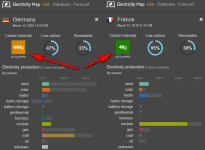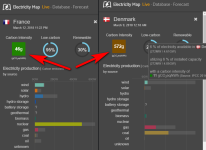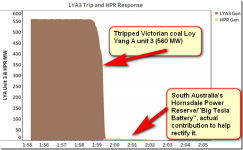TheBeastie
1 MW
http://shrinkthatfootprint.com/wp-content/uploads/2009/08/electricitynationality.gifCephalotus said:sendler2112 said:Thankfully we have objective data from electricity map .org. Germany has been over 400gm/kWh carbon all winter. Often times over 500. It still gets the vast majority of electricity from brown coal during the winter when the sun and wind are consistently bad.
This does not contradict what I wrote.
400-500g CO2/kWh is not super bad and an improvement compared to 15 years ago.
I don't understand why you show Germany as a negative example for wind and solar. We are coming from a very high percentage of burning lignite and for that our actual emission including significant amounts of wind and solar 8and less nukes) is not so bad comapred to other nations.

Its a decent chart that one because it shows France at 0.10 and Germany 0.52!
Thats over 500% higher amount of co2 than what France does. As I said in my earlier post, if you had two cars on the road and one emitted 500% (5 x times) the amount of co2 than the other car, then you instantly dismiss that other car as a total joke and not really lowing emissions at all.
And thats where we are with wind and solar vs nuclear.


These are 10 times co2 emissions than France, thats 1000%, if you look at them at any of your most preferred times its usually 500% or 5 times as much as France. Again if we were comparing "green cars" the wind/solar performance would be considered a complete joke and utter failure.
Now Germany is dotted with all these solar farms where trees once sat, so now the photosynthesis process of sucking co2 out of the air is gone, instead replaced with an incredibly bad performing 10% solar capacity factor.
https://youtu.be/x1SgmFa0r04?t=1m
Germany Solar capacity: 40.7GW (40,700MW)
Generated 2017: 38.39TWh
(38,390,000MWh / 8765.5hours_in_a_year_average) = 4,379MW average power generation (4.37GW)
So ( 4,379MW / 40,700MW ) x 100 = 10.7% capacity factor for solar.
If you went into a restaurant and asked for a steak dinner that was 10% of its advertised size, you wouldn't buy it.
Its so easy just to look at Germany in satellite view, look at were established trees are/were and see them being cut down for solar farms that generate 10% of their claimed capacity. When it could of been soaking up co2 like the NASA co2 map videos show.
https://goo.gl/maps/WFdC3pmvGjt
https://goo.gl/maps/qXsTPqK6hrp
https://goo.gl/maps/ghWzKkMSAuL2
https://goo.gl/maps/29Bnn6tNGEy
https://goo.gl/maps/nTPUZEqLd9r
https://goo.gl/maps/HUTmgZutZV92
https://goo.gl/maps/C4erWmdZWby
https://goo.gl/maps/f8j7176ei2m
https://goo.gl/maps/ZE2EYB4oYGo
https://goo.gl/maps/okMZYP4UnUA2
https://goo.gl/maps/HrSg7ZizTNR2
https://goo.gl/maps/ghWzKkMSAuL2
https://goo.gl/maps/TBCDSq5TDEo
https://goo.gl/maps/h5nu6t3HJq32
https://goo.gl/maps/DrKbXtzuRGU2
https://goo.gl/maps/AdfRYSh759p
https://goo.gl/maps/ucmLyiMFfdL2
https://goo.gl/maps/tWS3PTpDppt
None of this is helping the environment, you don't help the environment by cutting down trees to generate tiny amounts of power. I have no doubt everyone will see it that way in time, it just might be a very very long time.
Trees are just so important, more important than solar panels.
https://youtu.be/KZN6QuAdxLI
[youtube]KZN6QuAdxLI[/youtube]
https://www.youtube.com/watch?v=XVUAgcSCP_U
[youtube]XVUAgcSCP_U[/youtube]
The sun is a nuclear reactor it just doesn't use uranium as its fuel, the specifics of the nuclear reaction process simply do not matter if your being subjected to the radiation, the radiation from the sun covers the whole spectrum but only certain spectrums make it through the atmosphere to the surface of the earth. The invisible nonthermal radiation is Ultraviolet radiation.
https://en.wikipedia.org/wiki/Radiation#Ultraviolet_radiation
https://www.youtube.com/watch?v=PQjL4ZDuq2o
https://youtu.be/nNzDXXUiqRs
https://youtu.be/nNzDXXUiqRs?t=1m13s
https://en.wikipedia.org/wiki/Sunlight#Composition_and_power
The Sun emits EM radiation across most of the electromagnetic spectrum.
The Sun also emits X-rays, ultraviolet, visible light, infrared, and even radio waves;[13] the only direct signature of the nuclear process is the emission of neutrinos.
https://en.wikipedia.org/wiki/Nuclear_fusion#Nuclear_fusion_in_stars
An important fusion process is the stellar nucleosynthesis that powers stars and the Sun. In the 20th century, it was recognized that the energy released from nuclear fusion reactions accounted for the longevity of stellar heat and light.
The easiest way to look at it is you don't get sunburns from sitting in front of an electrical heater all day. Because its not emitting high amounts of UV radiation.
https://en.wikipedia.org/wiki/Sun_tanning
https://en.wikipedia.org/wiki/Sunburn
I said on my last post its a spectrum from the nuclear reactor of the sun, the fact the specific spectrum has folks running around in circles shows the incredible cluelessness on what is a pretty simple topic.
Radiation is very simple, I am disappointed/surprised I have to post this stuff https://en.wikipedia.org/wiki/Electromagnetic_spectrum
But of course it has come clear this whole thread is about drilling through the brain of clueless people who aren't interested in the truth or the science on anything. Everytime I post youtube links to bits of science documentries people get upset https://youtu.be/3ItOIz5gJiQ
Do you get this sitting in front of a heater inside your home? No, because the sun is emitting its nasty DNA damaging radiation.

You can just google "sunburn" in image search and get an endless stream of burns from radiation that you don't get from sitting in front of a heater.
https://www.google.com.au/search?q=sunburn&safe=off&rlz=1C1CHFX_enAU777AU777&source=lnms&tbm=isch&sa=X&ved=0ahUKEwi3rZvj8vzZAhUK2LwKHaN3C3sQ_AUICigB&biw=1857&bih=1014#imgrc=hLvC9SFUhiPgOM:


As for the new policy of South Australia government policy of a Tesla power-wall+solar roof systems, with a $2,500 rebate, as this article says its going to cost around $24,000 in Australia, and arguing if its a good or bad policy doesn't really matter because compared to getting it for free, almost no one's going to pay $22,000 for it. I think for the most part the new SA government are perfectly happy with that. Its a policy based around the idea that they didn't technically completely kill it
http://catallaxyfiles.com/2018/03/19/david-bidstrup-is-it-a-new-start-in-sa-or-just-more-of-the-same-bullshit/





